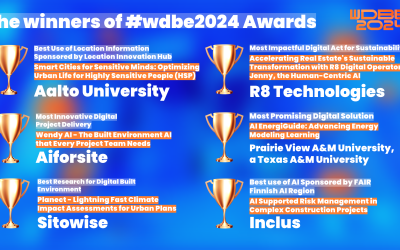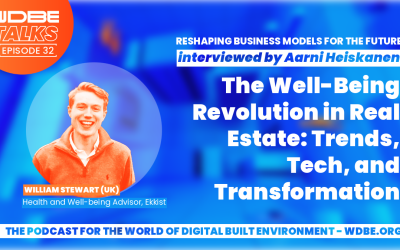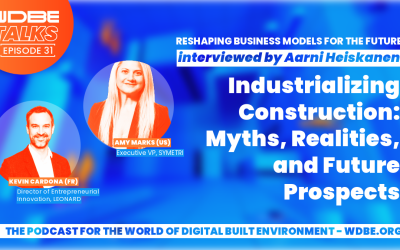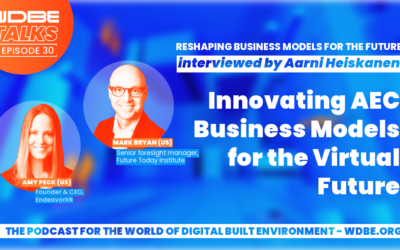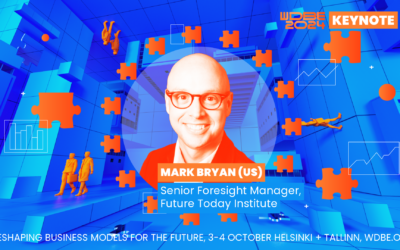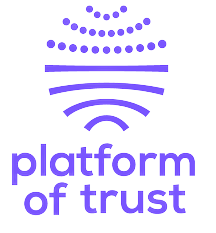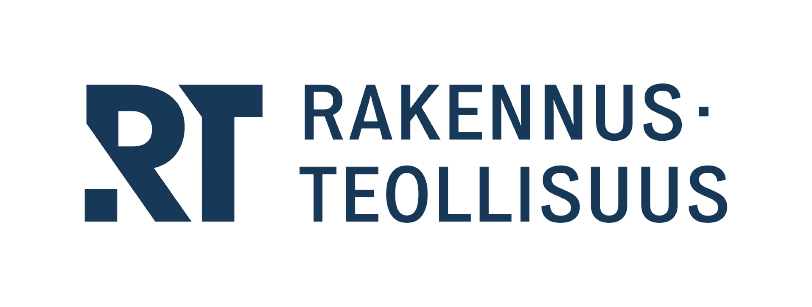
WDBE UPDATES // Meet our keynote speaker!
Closing the Loop: Discussing Automation and Realtime Supersensing with Brian Ringley
In the run-up to WDBE 2021, we sat down with Brian Ringley, Boston Dynamics’ Construction Technology Manager. Our discussion covered the technical challenges involved in implementing robots on construction sites, the obstacles standing in the way of autonomy, and the renewed value of data capture.
If one thing is clear, Covid has produced a call for automation. The recent disruption has highlighted a renewed need for safe and timely on-site reporting, alongside the ability to take a ‘hands-off’ approach to repetitive or dangerous tasks..
But requesting an answer to a problem is a very different beast from providing the right one for a diverse range of clients.
Answering the Call
The solution to this problem is currently being unpacked by designers at Boston Dynamics. After making headlines with the iconic launch of BigDog in 2005, their teams introduced Spot in 2016, and it was not long after that Brian Ringley saw the answer to his prayers.
“Before joining Boston Dynamics, I was educated as an architect and worked in a practice as a design technologist,” says Ringley. “This led to my next job as a construction researcher for a few years. At the time I was trying to understand two things: How to industrialize the construction of buildings through off-site methods, and how to develop a robust progress tracking program on-site.”
For Ringley, finding ways to track progress on site using human labor, fixed sensor systems, and wheeled and tracked robots produced constant logistical issues in such dynamic environments. However, in 2018, Ringley was finally exposed to Boston Dynamic’s Spot.
“Seeing the potential in Spot – knowing that it could autonomously take a sensor such as a camera or laser scanner anywhere in a chaotic construction environment – directly led to my interest in working at Boston Dynamics. Because I knew that that’s where I could have a really big impact on the construction industry,” he says.
Digital Futures
In his current role, Ringley supports newly possible continuous reality capture workflows supported by the use of automated robots, Digital Twins, and BIM technology. These digital tools allow practitioners to make full use of the sensor data captured by automated units and draw out project-specific insights.
However, bringing robots like Spot into live construction environments creates a unique series of practical challenges.
“There is a lot to consider. Sites are defined by dynamic obstacles. That could be a pallet of materials in the way, somebody coming around a corner, moving vehicles and equipment. And it all changes moment to moment,” he says. “Then there’s physical obstacles that can introduce risk. You’ve got gaps in the floor. Holes, barriers, cabling, piping, piles of materials, wet spots, puddles, standing water. You name it! We are deploying into a real, constantly changing environment. Not a polished, flat surface where you can use AMRs or large open spaces where you can effectively deploy a fleet of drones.”
For Ringley and his team, progress means the use of agile, mobile robots to capture data in a construction site. This information is then fed into a unified model that gives live updates and oversight, creating a ‘foundation of reality’ that can potentially scale from a single building project to complex urban environments.
Constant exposure to timely, validated data means that client decision-making becomes more informed. Users are ultimately rewarded with a full oversight of their project and the potential ability to model, build, and prefabricate materials on demand.

Get your ticket to the WDBE Summit 28–29 Sept 2021 (199€ + VAT)
Obstacles to Autonomy
A current, key objective for Boston Dynamics is reducing the friction required to implement a robot-mounted sensor solution on-site. A large part of this is working directly with customers to discuss their specific ROI goals and use those goals to develop robotic application requirements.
“It’s our responsibility to educate users. I do think people can have false notions of what autonomy means and what’s truly valuable about it,” he says. “First and foremost, there will always be collaboration. Value is unlocked when robots are paired with human intelligence, and together you are able to do things that simply weren’t possible before. You may be physically hands-off in terms of the day-to-day data capture work of the robots. But the human element is there in terms of planning, remote monitoring, data analysis, and team communication.”
For Ringley, this boils down to a user’s capacity to ‘trust’ autonomous units. In practice, these operate on-site, acquire the necessary data, and return to an assigned base (the “Spot Dock”) where they recharge. Once docked, they can pass data to the cloud where it is fed back into digital models and works to supply business insights and aid decision making.
It is, in fact, the very process that Boston Dynamics uses to capture information about the performance of their units and is used to drive improvements in-house.
“It’s our secret weapon [laughs]. We had a lot of really great early adopters and continue to have really insightful customers, and we have hundreds of robots out in these environments and on job sites. This lets us learn at an accelerated pace in the real world, which is much more valuable than simulation or testing in a lab. It’s incredible how much you learn just from a few days in the field with the customer.” Ringley says.
The Cost of Covid
It is this kind of a practical, customer-led approach that would conventionally be derailed by Covid.
But, for Boston Dynamics, disruption didn’t mean sacrificing opportunities for learning and innovation.
For Ringley’s team, the lockdown period forced employees to deliver sales demonstrations through the internet. Fortunately, their remote sales platform used the same remote operation capabilities and software as was deployed with their customers on-site. This meant clients, customers, and staff were able to deliver instant feedback on performance; allowing Boston Dynamics to implement useful functionality and UI changes across the period.
But, as with most innovation, the most useful piece of insight arrived almost by accident.
“There is of course a use-case for deploying robots in dangerous environments. The thing was…Covid made every environment potentially dangerous. All of a sudden, remote access became incredibly important on construction sites,” he says. “We were presented with situations where there was no access. At all. This led to some thinking about how that exacerbated communication challenges for many stakeholders – many of whom never really had that big of a level of access in the first place. How does an owner remotely check in on progress? How do you minimize unnecessary density on site? It opened doors. There’s no question about it.”
Ultimately, automated sensor technology allowed users to ‘close the loop’ when it came to information capture. This granted continuous feedback and insight to users on and off-site, allowing for unparalleled, validated decision making.
“Design models aren’t actually connected to what’s going on onsite,” Ringley says. “So you can’t make fully confidant decisions with them. Imagine being able to see that information in real-time. The impact of logistical changes. Or how things are being installed relative to design intent. It lets you catch issues as they happen, course correct, and learn from your mistakes.”
In an age where prefabrication, sustainability, and efficiency are more desirable than ever, it’s a tempting prospect for many.
What’s next?
Currently, Ringley and his team are working in partnership with Trimble Inc. to combine Spot with Trimble’s leading sensor technology and data-collection systems. The goal is to offer an out-of-the-box solution for on-site scanning that adapts to bespoke demands and supports a ‘closed loop’ approach to data capture using autonomous robots.
Or as Ringley puts it:
“I think it’s really attractive because, historically, it’s just been really expensive to scan complex environments. It’s a ton of work to scan, process, and analyse the point clouds, and it’s frankly, it’s not worth it for most building owners. So our approach is to make it easy and make it cheap, and once it’s cheap there will be a paradigm shift from scanning once or twice per project for due diligence to scanning on a frequent basis for continuous progress tracking and change detection. Because that would be really effective, efficient, and helpful…and profitable for everyone [laughs].”
More Updates
WDBE 2024 Awards Winners: Highlighting the Advancement of Built Environment
The World of Digital Built Environment (WDBE) Summit announced the winners of the WDBE 2024 Awards which highlight notable digital advancement in the built environment. This year, submissions were received across six categories, showcasing practical and innovative solutions in areas such as sustainability, research, project delivery, and AI.
WDBE-talks: The Well-Being Revolution in Real Estate: Trends, Tech, and Transformation
In the podcast episode, William delved into the burgeoning field of health and well-being in the built environment, a relatively new focus within real estate. He shared his journey from project management and asset management to his current role, driven by a keen interest in how our living and working environments impact our health.
WDBE-talks: Industrializing construction: Myths, Realities, and Future Prospects with Amy Marks and Kevin Cardona
In the podcast episode, Amy and Kevin discuss the challenges the construction industry faces and the necessity of shifting business models to achieve more sustainable and efficient construction practices.
WDBE-talks: Innovating AEC Business Models for the Virtual Future with Amy Peck and Mark Bryan
In this episode of WDBE Talks, Aarni Heiskanen had the pleasure of hosting two distinguished guests from the USA: Amy Peck, Founder and CEO of EndeavorXR, and Mark Bryan, Senior Foresight Manager at Future Today Institute. Amy and Mark will deliver keynotes at the upcoming WDBE 2024 conference, focusing on reshaping built environment business models for the future.
Digital Transformation of the Built Environment Sets New Requirements: Future Today Institute Expert Sheds Light on Future Prospects at WDBE2024 Summit
Mark Bryan, Senior Foresight Manager at the Future Today Institute, which focuses on strategic foresight, has been confirmed as a speaker for the World of Digital Built Environment (WDBE) 2024 Summit.
WDBE-talks: New Business Models Unveiled with Olivier Lepinoy and Jaan Saar
In this WDBE Talks episode hosted by Aarni Heiskanen, two WDBE 2024 keynote speakers,
Olivier Lepinoy and Jaan Saar, discuss the significance of reimagining traditional business
models within the construction sector.
Olivier is the visionary founder of HYPER Construction, and Jaan is the Chief Evangelist at Future
Insight. Both thought leaders have experience innovating business models and share their
insights in this podcast.

